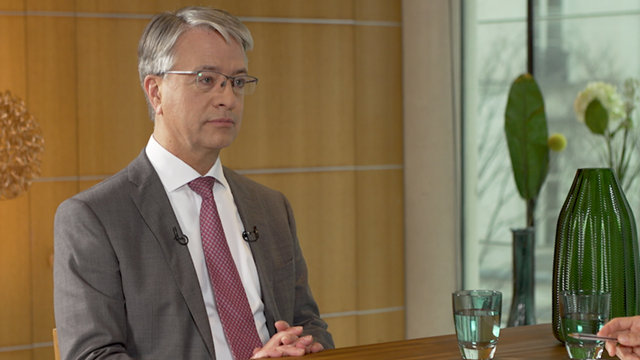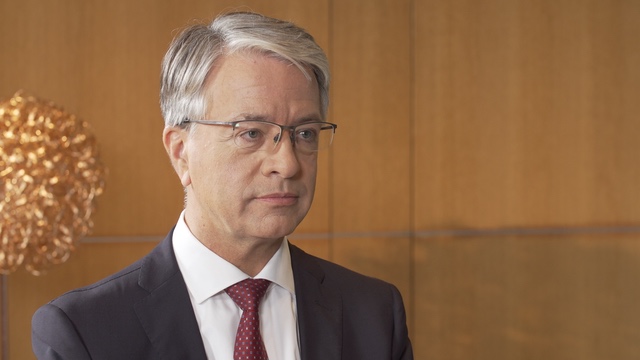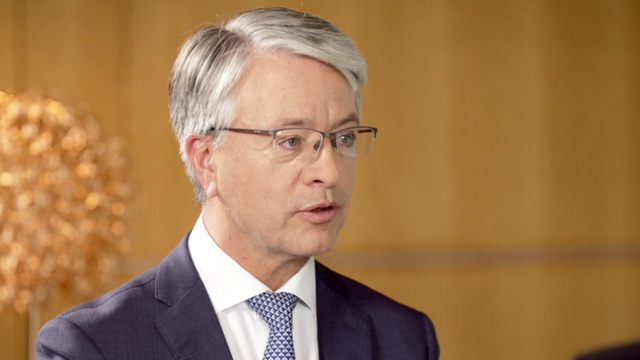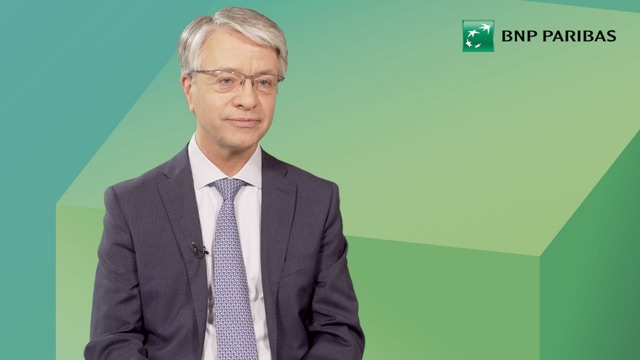EuroBusiness Media (EBM): BNP Paribas, one of the Europe’s largest banks, reports earnings for the third quarter of 2010. Baudouin Prot, welcome. You are the CEO of BNP Paribas. What are your comments on the Group’s performance in the third-quarter?
Baudouin Prot (BP): In a risk averse environment, BNP Paribas benefited from its diversified and client-centric business model once again.
As for revenues, despite a very high comparison base in the third quarter of 2009 due to CIB, the Group’s revenues were up 1.8 percent to 10.9 billion euros.
The decrease in the cost of risk, by 47 percent, resulted in a pre-tax income of 3.1 billion euros, up 29 percent from the third quarter of 2009.
All in all, BNP Paribas posted a net profit of 1.9 billion euros thanks to a strong rebound in Retail banking activities, a result commensurate with its strong and sustainable earnings generation capacity. Over the first nine months of 2010, the Group’s earnings per share grew by 37.6 percent to 5.12 euros and Return on Equity stands at 13.2 percent - a level of profitability that is amongst the highest in the industry.
These results enable BNP Paribas to reach a high common equity Tier one ratio of 9 percent.
EBM: What drove your CIB division results in Q3? Does the theme of benefiting from weaker competitors following the financial crisis still hold true and how sustainable is it?
BP: This quarter, markets showed lower levels of volatility than in Q2 but clients still demonstrated widespread risk aversion. In such a context, revenue contribution from the different businesses was more balanced.
Financing businesses have once again proven to be extremely resilient with strong and recurring revenues, in particular in Energy and Commodities structured finance, as well as Acquisition financing, which confirmed a rebound. The Group is clearly positioned as a world-class leader in these activities.
As for Capital Markets, the Fixed Income platform has again shown its ability to keep its number one ranking for all issues in Euro - a market that reopened after Q2’s difficult conditions resulting from the Sovereign debt crisis. Despite the revival of competition, BNP Paribas’ market share has increased in Corporate Bonds.
Equity Derivatives saw a rebound in revenues, with a lower costs of hedging client positions than in Q2 combined with successful selling of structured products through banking and insurance networks.
All in all, although competition is back, BNP Paribas CIB’s very efficient set-up continues to translate into a very competitive cost income ratio. At 52.5 percent over the first 9 months of 2010, it is the best level in the industry.
EBM: Given the regulatory tightening on capital requirements, how much of your business model is called into question?
BP: The regulatory tightening of capital requirements will be manageable for BNP Paribas, without the need for any capital increase. Our client-centric and diversified business model as well as our capital allocation (with more than 50 percent in retail) are well adapted to the post-crisis environment.
The new regulatory environment will generate a disintermediation trend which will benefit BNP Paribas’ already strong Fixed Income franchise.
EBM: Interest rates appear durably low, what is the impact on your retail banking division in your domestic markets that are France, Italy, Belgium and Luxembourg? What is your strategy in a context of durably low interest rates?
BP: The revenues of BNP Paribas’ main retail banking businesses in its domestic markets have all progressed well this quarter despite a low interest rate environment.
In France and BeLux, customer loans continued to demonstrate good momentum with a healthy growth of 3 and 2 percent respectively, boosted by mortgage production – that reached its highest level ever in France in August. Growth of current accounts was solid, at 11 and 13 percent respectively. Therefore, in France, net interest income grew by 3.5 percent compared to the third quarter of last year.
In Italy, BNL bc posted a 1.2 percent increase in net interest income, thanks to a stabilised margin on credit together with a growth in deposits.
Of course, the flattening of the yield curve combined with low interest rates is not favourable for net interest income. However, ALM is aimed at mitigating the impact of interest rate and maturity gaps. Moreover, outperformance and market share gains through product innovation and better services will also contribute to improving results.
EBM: What is your outlook for BNL bc in Italy, where interest rates remain low and the cost of risk remains high?
BP: BNL bc has seen some positive trends over the quarter: growth in investment loans to Corporates as well as loans to local authorities in addition to higher transaction volumes in its Cash management activities.
The cost of risk stands at 108 bp and is now in a stabilisation phase, as already seen in the previous two quarters, although it is too early to envisage a decline.
In this context, BNL has proved its ability to perform better than its competitors, while continuing to open new branches and launch new commercial initiatives. It has confirmed its strong efficiency in controlling costs. In 3Q10, the cost/income ratio reached 57.3 percent, now at a lower level than its peers. In the mean time, BNL has successfully defended its market shares or even increased them.
EBM: BancWest has returned to profit, but how sustainable is this? What is your scenario for BancWest in a context which remains difficult in the US, and in California in particular?
BP: BancWest continues to experience soft credit demand but has seen encouraging stabilisation of outstanding loans compared to previous quarters, with an increase in corporate and consumer loans as well as improving margins on new production. Core deposits continue to grow strongly, at around 8 percent versus the third quarter of 2009.
On the costs side, after a strict cost cutting program, commercial expenses have picked up in order to sustain commercial initiatives.
Thanks to the improvement in the quality of the loan book, the cost of Risk continued to decline.
Once again this quarter, BancWest confirmed a return to significant profit.
EBM: What drove the performance of your Personal Finance division this quarter?
BP: Personal Finance benefits from a proactive growth and industrialisation strategy recently illustrated by the creation of Commerz Finanz, a consumer lending business with Commerzbank, and a business alliance with BPCE, creating a common IT platform to manage consumer loans.
This quarter, top line increased by 3.6 percent compared to the third quarter of 2009, on a like for like basis, thanks to a 4.3 percent growth in outstanding loans.
Furthermore, both consumer and mortgage production are growing.
Thus, the drop in Personal Finance’s cost of risk lead to an almost two-fold increase in its pre-tax income compared to 3Q09 on a like for like basis.
EBM: The interest of investors for equities is waning -- what are the foreseeable consequences for the revenues of your asset gathering activities in the short-term?
BP: Investors’ risk aversion is currently high as illustrated by persistently low market volumes and historically low interest rates.
Nevertheless, once again this quarter, Investment Solutions results have shown resilience, posting a 6 percent increase in revenues compared to the third quarter of 2009 despite this challenging market environment. This good performance was achieved thanks to the diversified business mix of this division that encompasses Asset management, Wealth management, Insurance and Securities Services.
While Asset and Wealth management divisions suffered from risk aversion and low interest rates, Insurance has benefited from them. As for Securities Services, it has benefited from higher levels of assets under custody and administration.
EBM: The asset management sector is consolidating and industrializing. What are the consequences for your own asset management business? Are you in favour of a low-cost, mass-market strategy for your retail products?
BP: The integration of BNP Paribas Investment Partners and Fortis Investments is a transforming transaction leading to the creation of a strong player in Europe with a significant position in emerging markets. It enables BNP Paribas to offer its products and investment solutions across several European markets, while strengthening its international positioning. The significant cost synergies resulting from the integration will further improve the cost competitiveness of the platform.
However, low cost is not a strategy in itself. Our strategy is to develop and propose products that address our clients' needs and create value. Products must correspond to the life or savings projects of our private investors.
EBM: What do you think of the new Basel III regulations? Do you think it's necessary for BNP Paribas to go further and higher than Basel III in terms of capital?
BP: We fully support the new common definition of capital.
Capital requirements should take the risk profile of each bank into consideration and should not take a one size fits all approach.
Additional capital requirements under Basel 3 regulation are unwarranted for a bank like BNP Paribas that neither originated subprime loans nor cost a single euro to tax payers in what can be qualified as a once in a century financial crisis. Indeed, BNP Paribas’ capital was not dented throughout the crisis proving the resilience of its diversified and client-centric business model and stringent risk management over the cycle.
Hence, I consider that there is no reason, whatsoever, for BNP Paribas to target a level of capital above the minimum requirements.
EBM: Could you assess the impact of Basel 2.5 and Basel 3 rules on the group’s risk weighted assets?
BP: Thanks to its diversified customer-driven business model, the new Basel Committee rules, still under discussion, will have a significant but manageable impact on the group’s risk weighted assets. It should represent, in total, roughly 70 billion euros of additional risk weighted assets.
EBM: Although you failed to make an acquisition recently in Poland, you are still rumoured to be actively pursuing another acquisition in Poland. You have also stated that you would perform a capital increase in case of a major acquisition. Should we expect a capital increase for any forthcoming potential Polish acquisition?
BP: We never comment on rumours. In any case, BNP Paribas always sticks to its strict financial acquisition criteria:
_-the acquisition has to be accretive from at least the third year following the acquisition and,
_-in addition, the return on invested equity has to be above the cost of capital of the target by the third year.
EBM: How is the integration of Fortis progressing?
BP: The integration of Fortis is a major industrial project that involves almost all business units of BNP Paribas and brings a new dimension to each of them. The integration is being executed efficiently and swiftly as illustrated by the amount of synergies already implemented that reached 612 million euros this quarter out of an expected total of 900 million euros by 2012. This really demonstrates that we are ahead of the schedule outlined in the integration plan.
EBM: Baudouin Prot, CEO of BNP Paribas, thank you very much.
BP: You’re welcome.






